Optimized Materials Properties for Organosilicate Glasses Produced by Plasma-Enhanced Chemical Vapor Deposition
- PDF / 213,070 Bytes
- 6 Pages / 612 x 792 pts (letter) Page_size
- 7 Downloads / 289 Views
E8.17.1
Optimized Materials Properties for Organosilicate Glasses Produced by Plasma-Enhanced Chemical Vapor Deposition M.L. O’Neill, R.N. Vrtis, J.L. Vincent, A.S. Lukas, E.J. Karwacki, B.K. Peterson, and M.D. Bitner Air Products and Chemicals, Inc., 7201 Hamilton Blvd., Allentown, PA 18195 Abstract In this paper we examine the relationship between precursor structure and material properties for films produced from several leading organosilicon precursors on a common processing platform. Results from our study indicate that for the precursors tested the nature of the precursor has little effect upon film composition but significant impact on film structure and properties. Introduction There are a variety of materials being considered for the next generation interlayer dielectric (ILD) materials. The leading candidates for the 90nm generation are organosilicate glasses produced by Plasma-Enhanced Chemical Vapor Deposition (PECVD). Providing materials with extendibility beyond a single generation solution requires the optimization of both electrical and mechanical properties. These are competing goals since concomitant with reducing the dielectric constant (k) is, in general, a decrease in the mechanical strength of a material. The goal of this work is to build a better understanding of the structure of low k dielectric films deposited from a PECVD process. In attempts to elucidate structureproperty relationships for OSG precursors we assessed a variety of chemicals including those used in various commercial product offerings. Experimental All experiments were performed on an Applied Materials Precision 5000 fitted with a 200mm DxZ chamber. Every attempt was made to optimize process regimes for each precursor to provide the best mechanical properties at a given dielectric constant (k). Films were analyzed for refractive index and thickness with a SCI FilmTek 2000 reflectometer calibrated daily. Electrical tests were performed on low resistivity wafers (< .02 ohm-cm) using a mercury probe calibrated with thermal oxide standards of various thicknesses. Errors in film thickness and capacitance contributed to an error of ±5% in k; typical measurement standard deviation was within ±3%. Mechanical properties were evaluated by nanoindentation using a MTS model SA-2 on films greater than 750 nm thick as per manufacturers protocol [1] (multi-sample average, modulus / hardness quoted at 50 / 100nm depth, respectively; measurement error ± 10%, standard deviation typically less than ±5%). Atomic composition by X-ray photoelectron spectroscopy (XPS) was collected on a Physical Electronics 5000LS ESCA spectrometer after Ar beam sputtering to remove the topmost 20Å from the surface of the film. Bonding structure and functional group analyses were performed by transmission FT-IR spectra on high resistivity wafers (> 20 ohm-cm) using a Thermo Nicolet 750 at 4 cm-1 resolution, nitrogen purged cell and background corrected with Si. Selected samples were analyzed using Carbon-13 and Silicon-29 Nuclear Magnetic Resonance (NMR). Density
Data Loading...











